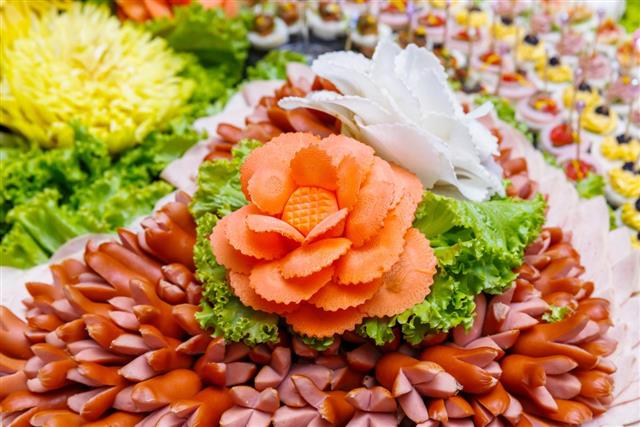
Flowers carved out of vegetables look very fascinating and decorative. You can make them yourself by following these useful tips on vegetable carving.
Vegetables are a crucial part of our daily diet. They provide us the essential vitamins and minerals that are required for the healthy growth of our body. Apart from eating, vegetables can be used to create beautiful flowers that are meant for a decorative purpose. They are used on different occasions such as weddings, receptions, or parties. They offer a touch of elegance and glamor to the ambiance. These flowers can be kept on the dining tables or used to garnish the dishes. An interesting thing about these carved flowers is that they are edible. Most carvings are quite simple and can be easily done at home.
Selection of Vegetables
For carving, you need to select the fresh, firm vegetables. Some vegetables such as onion, carrot, tomato, cucumber, pumpkin, melon, potato, radish, and squash are perfectly suitable for carving. These vegetables can be used to create decorative flowers as well as elaborate birds, boats, and dragons.
Each vegetable has its own unique characteristics. Shallots and onions should be fresh and without wrinkles. Carrots should be medium or large-sized and straight. You should select round, fresh, and firm radishes.
Preparation
You need to prepare the vegetables with certain processes, so that the flowers can be carved easily. Soak the tomatoes in a mixture of water and lime juice in order to prevent its browning. Onions and shallots should be soaked in water before peeling in order to minimize irritation of eyes.
You should wash the beets in salted water, which reduces loss of color. It should be kept moist by regularly spraying it with water to prevent it from turning black. Potatoes should be washed after peeling and again after carving to avoid browning.
Essential Tips and Pointers
Before carving, the vegetables should be thoroughly washed and cleaned. Use a sharp-pointed knife with a bronze or stainless steel blade. Ordinary steel blade of a knife can cause discoloration of vegetables.
Avoid excessive carving in order to prevent waste and loss of nutritional value. The designs you carve should suit the plate of food. The floral patterns go well with any kind of dish. If vegetables are to be dipped into sauces, then they should be cut in appropriate sizes.
Vegetables selected for carving should be resistant to drooping, such as Chinese radishes or carrots. Before going for carving the vegetables, you should have enough practice. It should be done with great care and concentration.
After carving, you should keep the vegetables in ice-cold water, so that the petals of carved flowers spread properly and remain firm. Carved flowers should not be left in water for a prolonged time, due to which petals may get discolored and spoiled.
Each type of carved vegetable should be placed separately, so that all your work would not be lost if one type of vegetable rots. Store the carved vegetables in a container and keep it in a refrigerator. If the refrigerator is not available, then cover them with a damp piece of thin cloth. Keep them in a protected place, so that they do not dry or wilt.







